HRM Assignment: Evaluating Performance Appraisal at Zubias Threading
VerifiedAdded on 2020/02/24
|7
|1485
|92
Report
AI Summary
This report evaluates the significance of performance appraisal within the Zubias Threading salon chain, addressing concerns of employee engagement and customer dissatisfaction. The research investigates the importance of aligning organizational goals with employee motivational needs, aiming to identify employee issues and recommend performance appraisal strategies. The report includes a literature review examining performance appraisal as a motivational tool, supported by theories like Equity Theory. The methodology involves both qualitative (focus group interviews with managers and customer interviews) and quantitative (employee surveys) research methods to gather data on appraisal policies and employee needs. The conclusion emphasizes the need for effective appraisal schemes to foster employee motivation and retention, offering recommendations based on the research findings. The reference list includes various academic sources supporting the research.
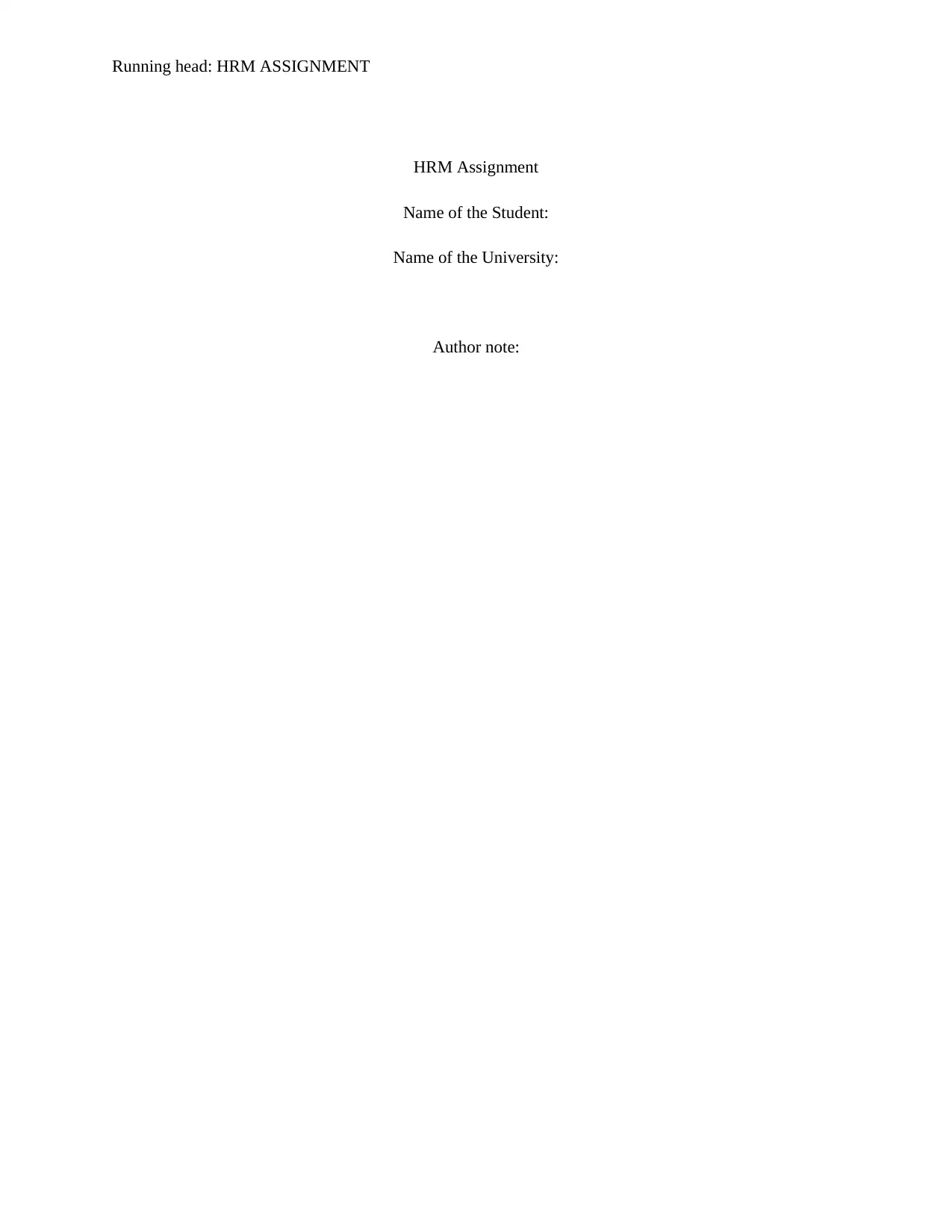
Running head: HRM ASSIGNMENT
HRM Assignment
Name of the Student:
Name of the University:
Author note:
HRM Assignment
Name of the Student:
Name of the University:
Author note:
Paraphrase This Document
Need a fresh take? Get an instant paraphrase of this document with our AI Paraphraser
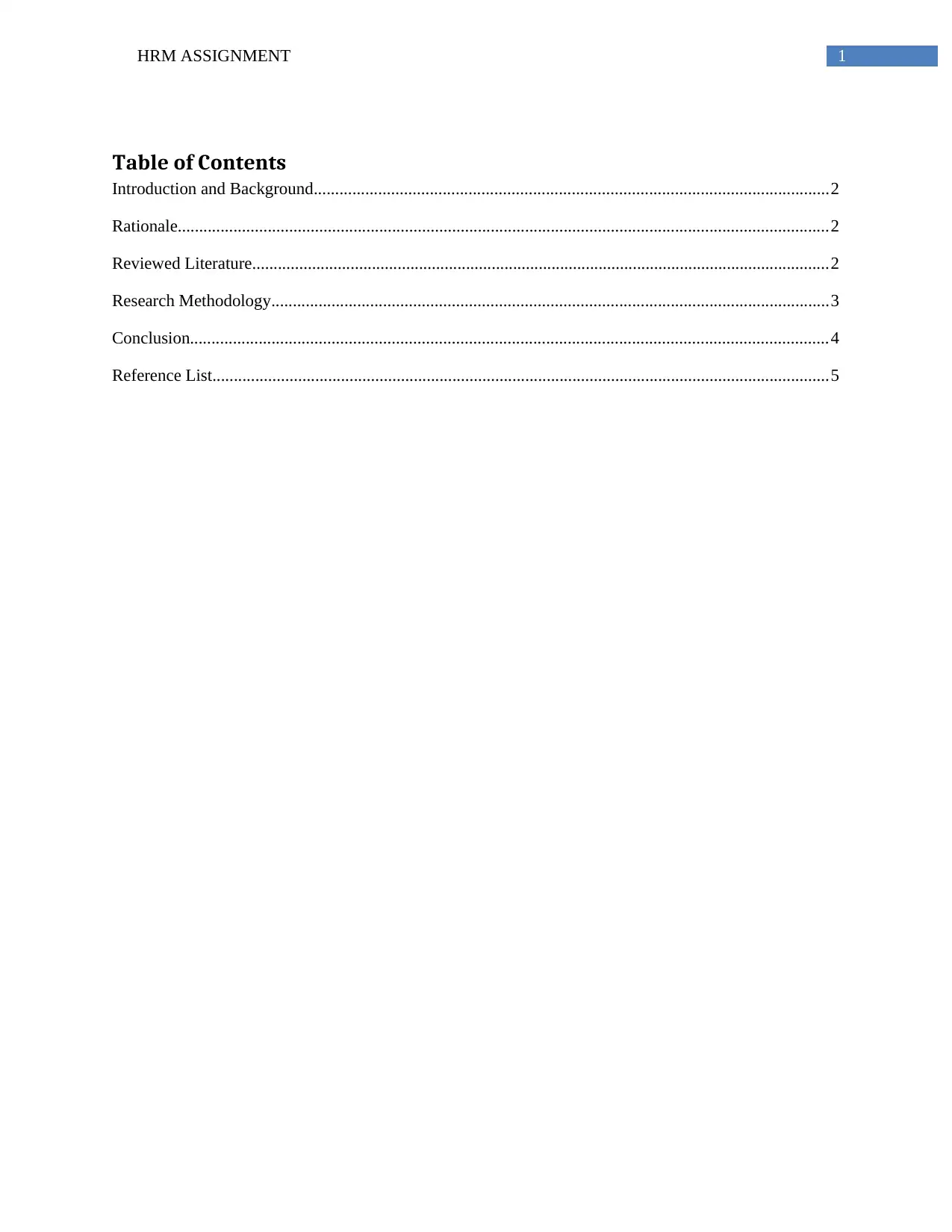
1HRM ASSIGNMENT
Table of Contents
Introduction and Background........................................................................................................................2
Rationale........................................................................................................................................................2
Reviewed Literature.......................................................................................................................................2
Research Methodology..................................................................................................................................3
Conclusion.....................................................................................................................................................4
Reference List................................................................................................................................................5
Table of Contents
Introduction and Background........................................................................................................................2
Rationale........................................................................................................................................................2
Reviewed Literature.......................................................................................................................................2
Research Methodology..................................................................................................................................3
Conclusion.....................................................................................................................................................4
Reference List................................................................................................................................................5
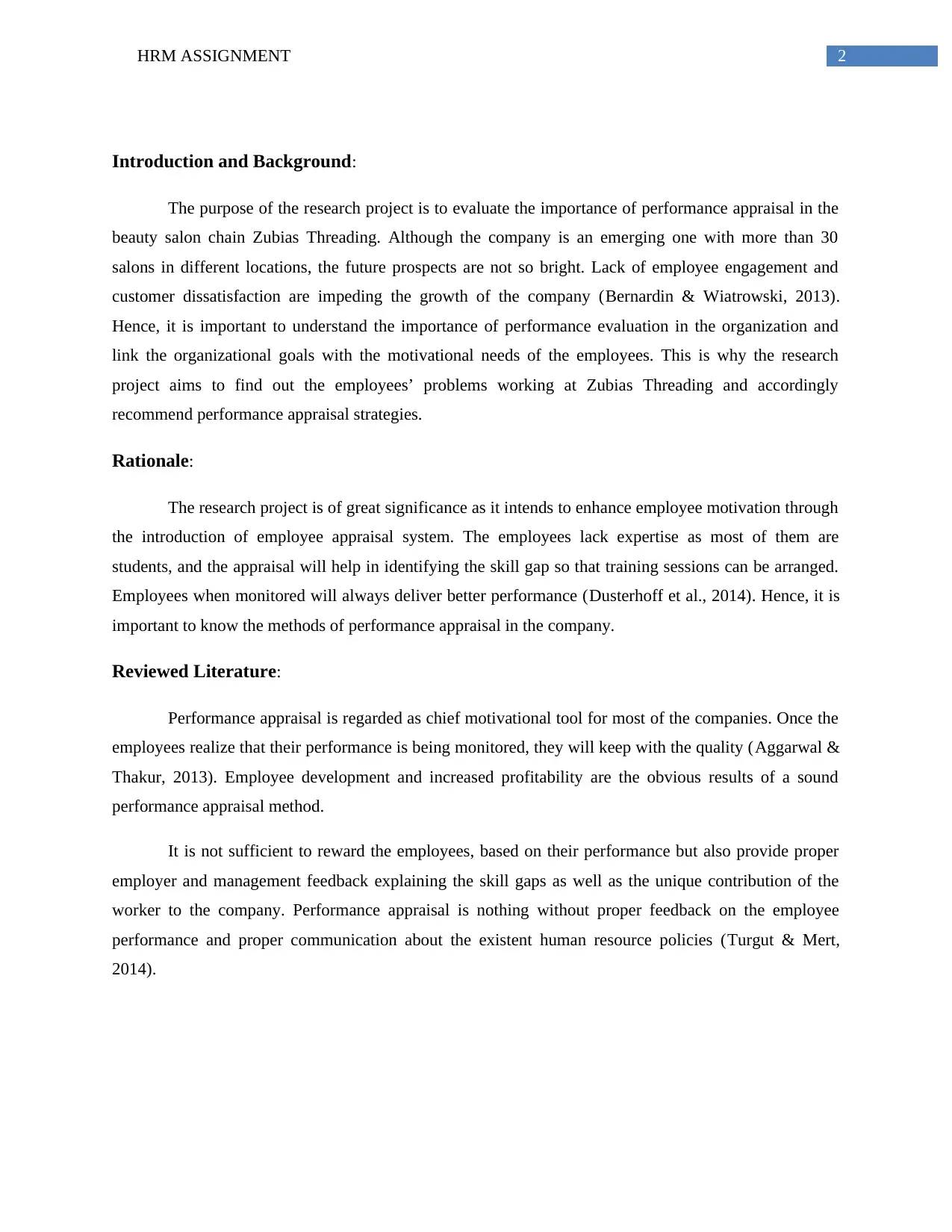
2HRM ASSIGNMENT
Introduction and Background:
The purpose of the research project is to evaluate the importance of performance appraisal in the
beauty salon chain Zubias Threading. Although the company is an emerging one with more than 30
salons in different locations, the future prospects are not so bright. Lack of employee engagement and
customer dissatisfaction are impeding the growth of the company (Bernardin & Wiatrowski, 2013).
Hence, it is important to understand the importance of performance evaluation in the organization and
link the organizational goals with the motivational needs of the employees. This is why the research
project aims to find out the employees’ problems working at Zubias Threading and accordingly
recommend performance appraisal strategies.
Rationale:
The research project is of great significance as it intends to enhance employee motivation through
the introduction of employee appraisal system. The employees lack expertise as most of them are
students, and the appraisal will help in identifying the skill gap so that training sessions can be arranged.
Employees when monitored will always deliver better performance (Dusterhoff et al., 2014). Hence, it is
important to know the methods of performance appraisal in the company.
Reviewed Literature:
Performance appraisal is regarded as chief motivational tool for most of the companies. Once the
employees realize that their performance is being monitored, they will keep with the quality (Aggarwal &
Thakur, 2013). Employee development and increased profitability are the obvious results of a sound
performance appraisal method.
It is not sufficient to reward the employees, based on their performance but also provide proper
employer and management feedback explaining the skill gaps as well as the unique contribution of the
worker to the company. Performance appraisal is nothing without proper feedback on the employee
performance and proper communication about the existent human resource policies (Turgut & Mert,
2014).
Introduction and Background:
The purpose of the research project is to evaluate the importance of performance appraisal in the
beauty salon chain Zubias Threading. Although the company is an emerging one with more than 30
salons in different locations, the future prospects are not so bright. Lack of employee engagement and
customer dissatisfaction are impeding the growth of the company (Bernardin & Wiatrowski, 2013).
Hence, it is important to understand the importance of performance evaluation in the organization and
link the organizational goals with the motivational needs of the employees. This is why the research
project aims to find out the employees’ problems working at Zubias Threading and accordingly
recommend performance appraisal strategies.
Rationale:
The research project is of great significance as it intends to enhance employee motivation through
the introduction of employee appraisal system. The employees lack expertise as most of them are
students, and the appraisal will help in identifying the skill gap so that training sessions can be arranged.
Employees when monitored will always deliver better performance (Dusterhoff et al., 2014). Hence, it is
important to know the methods of performance appraisal in the company.
Reviewed Literature:
Performance appraisal is regarded as chief motivational tool for most of the companies. Once the
employees realize that their performance is being monitored, they will keep with the quality (Aggarwal &
Thakur, 2013). Employee development and increased profitability are the obvious results of a sound
performance appraisal method.
It is not sufficient to reward the employees, based on their performance but also provide proper
employer and management feedback explaining the skill gaps as well as the unique contribution of the
worker to the company. Performance appraisal is nothing without proper feedback on the employee
performance and proper communication about the existent human resource policies (Turgut & Mert,
2014).
⊘ This is a preview!⊘
Do you want full access?
Subscribe today to unlock all pages.

Trusted by 1+ million students worldwide
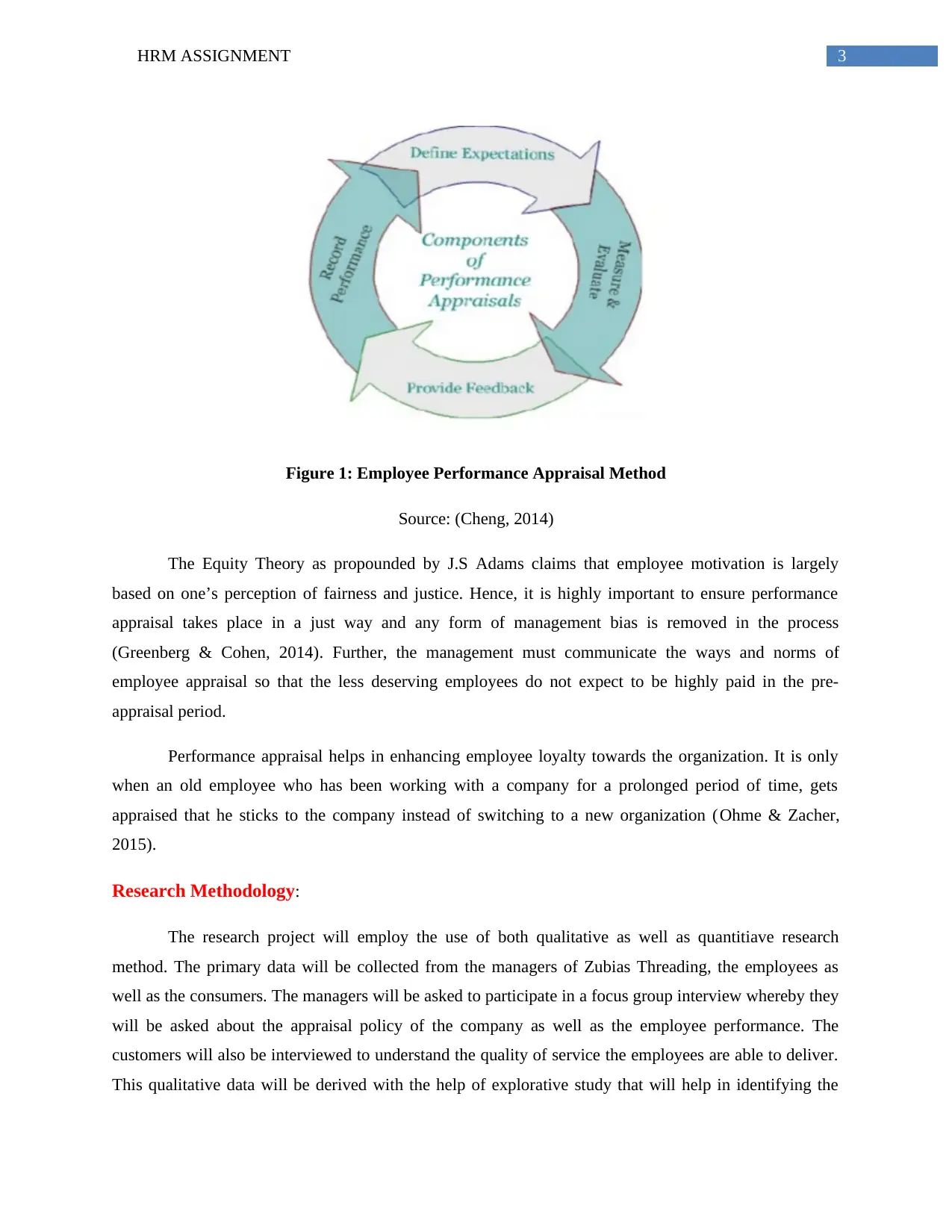
3HRM ASSIGNMENT
Figure 1: Employee Performance Appraisal Method
Source: (Cheng, 2014)
The Equity Theory as propounded by J.S Adams claims that employee motivation is largely
based on one’s perception of fairness and justice. Hence, it is highly important to ensure performance
appraisal takes place in a just way and any form of management bias is removed in the process
(Greenberg & Cohen, 2014). Further, the management must communicate the ways and norms of
employee appraisal so that the less deserving employees do not expect to be highly paid in the pre-
appraisal period.
Performance appraisal helps in enhancing employee loyalty towards the organization. It is only
when an old employee who has been working with a company for a prolonged period of time, gets
appraised that he sticks to the company instead of switching to a new organization (Ohme & Zacher,
2015).
Research Methodology:
The research project will employ the use of both qualitative as well as quantitiave research
method. The primary data will be collected from the managers of Zubias Threading, the employees as
well as the consumers. The managers will be asked to participate in a focus group interview whereby they
will be asked about the appraisal policy of the company as well as the employee performance. The
customers will also be interviewed to understand the quality of service the employees are able to deliver.
This qualitative data will be derived with the help of explorative study that will help in identifying the
Figure 1: Employee Performance Appraisal Method
Source: (Cheng, 2014)
The Equity Theory as propounded by J.S Adams claims that employee motivation is largely
based on one’s perception of fairness and justice. Hence, it is highly important to ensure performance
appraisal takes place in a just way and any form of management bias is removed in the process
(Greenberg & Cohen, 2014). Further, the management must communicate the ways and norms of
employee appraisal so that the less deserving employees do not expect to be highly paid in the pre-
appraisal period.
Performance appraisal helps in enhancing employee loyalty towards the organization. It is only
when an old employee who has been working with a company for a prolonged period of time, gets
appraised that he sticks to the company instead of switching to a new organization (Ohme & Zacher,
2015).
Research Methodology:
The research project will employ the use of both qualitative as well as quantitiave research
method. The primary data will be collected from the managers of Zubias Threading, the employees as
well as the consumers. The managers will be asked to participate in a focus group interview whereby they
will be asked about the appraisal policy of the company as well as the employee performance. The
customers will also be interviewed to understand the quality of service the employees are able to deliver.
This qualitative data will be derived with the help of explorative study that will help in identifying the
Paraphrase This Document
Need a fresh take? Get an instant paraphrase of this document with our AI Paraphraser
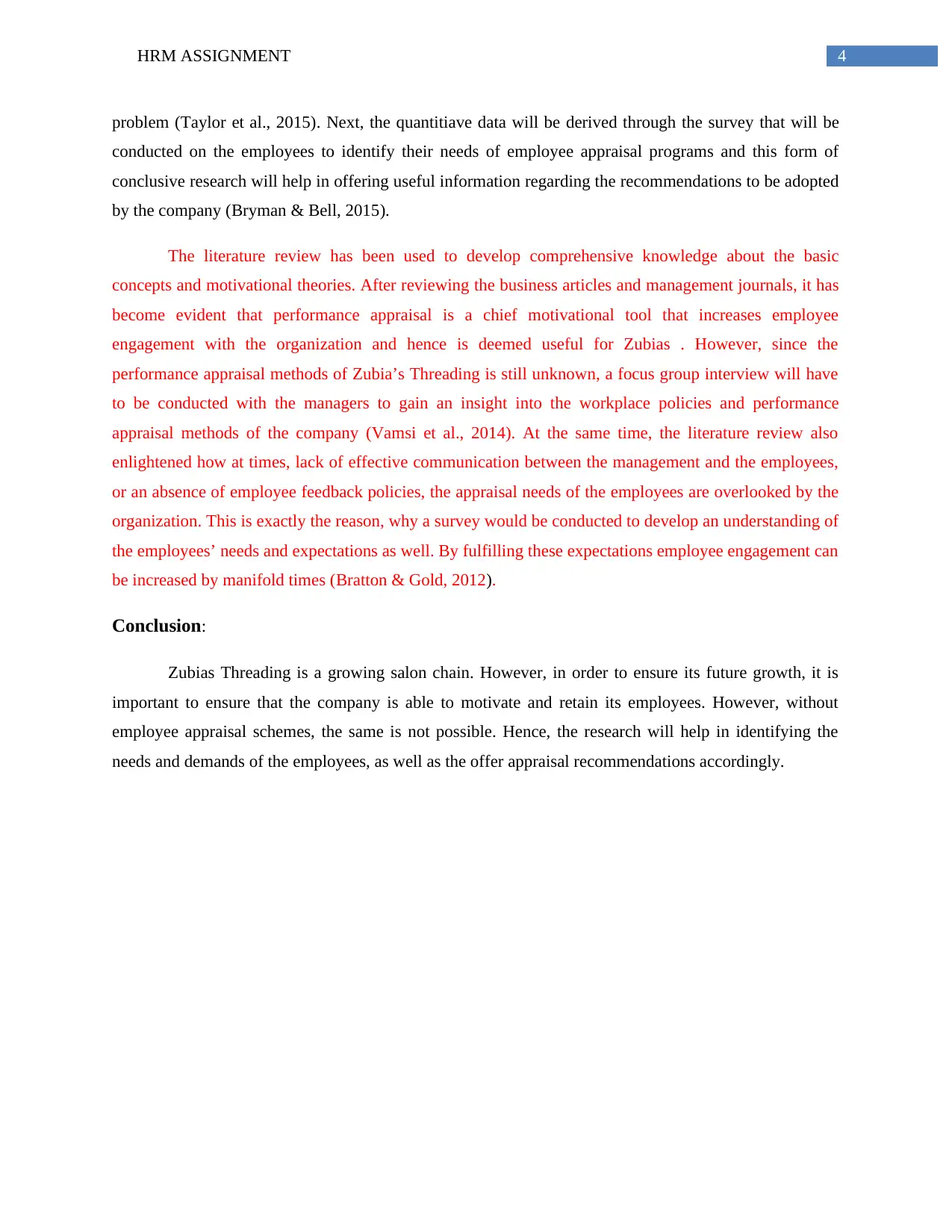
4HRM ASSIGNMENT
problem (Taylor et al., 2015). Next, the quantitiave data will be derived through the survey that will be
conducted on the employees to identify their needs of employee appraisal programs and this form of
conclusive research will help in offering useful information regarding the recommendations to be adopted
by the company (Bryman & Bell, 2015).
The literature review has been used to develop comprehensive knowledge about the basic
concepts and motivational theories. After reviewing the business articles and management journals, it has
become evident that performance appraisal is a chief motivational tool that increases employee
engagement with the organization and hence is deemed useful for Zubias . However, since the
performance appraisal methods of Zubia’s Threading is still unknown, a focus group interview will have
to be conducted with the managers to gain an insight into the workplace policies and performance
appraisal methods of the company (Vamsi et al., 2014). At the same time, the literature review also
enlightened how at times, lack of effective communication between the management and the employees,
or an absence of employee feedback policies, the appraisal needs of the employees are overlooked by the
organization. This is exactly the reason, why a survey would be conducted to develop an understanding of
the employees’ needs and expectations as well. By fulfilling these expectations employee engagement can
be increased by manifold times (Bratton & Gold, 2012).
Conclusion:
Zubias Threading is a growing salon chain. However, in order to ensure its future growth, it is
important to ensure that the company is able to motivate and retain its employees. However, without
employee appraisal schemes, the same is not possible. Hence, the research will help in identifying the
needs and demands of the employees, as well as the offer appraisal recommendations accordingly.
problem (Taylor et al., 2015). Next, the quantitiave data will be derived through the survey that will be
conducted on the employees to identify their needs of employee appraisal programs and this form of
conclusive research will help in offering useful information regarding the recommendations to be adopted
by the company (Bryman & Bell, 2015).
The literature review has been used to develop comprehensive knowledge about the basic
concepts and motivational theories. After reviewing the business articles and management journals, it has
become evident that performance appraisal is a chief motivational tool that increases employee
engagement with the organization and hence is deemed useful for Zubias . However, since the
performance appraisal methods of Zubia’s Threading is still unknown, a focus group interview will have
to be conducted with the managers to gain an insight into the workplace policies and performance
appraisal methods of the company (Vamsi et al., 2014). At the same time, the literature review also
enlightened how at times, lack of effective communication between the management and the employees,
or an absence of employee feedback policies, the appraisal needs of the employees are overlooked by the
organization. This is exactly the reason, why a survey would be conducted to develop an understanding of
the employees’ needs and expectations as well. By fulfilling these expectations employee engagement can
be increased by manifold times (Bratton & Gold, 2012).
Conclusion:
Zubias Threading is a growing salon chain. However, in order to ensure its future growth, it is
important to ensure that the company is able to motivate and retain its employees. However, without
employee appraisal schemes, the same is not possible. Hence, the research will help in identifying the
needs and demands of the employees, as well as the offer appraisal recommendations accordingly.
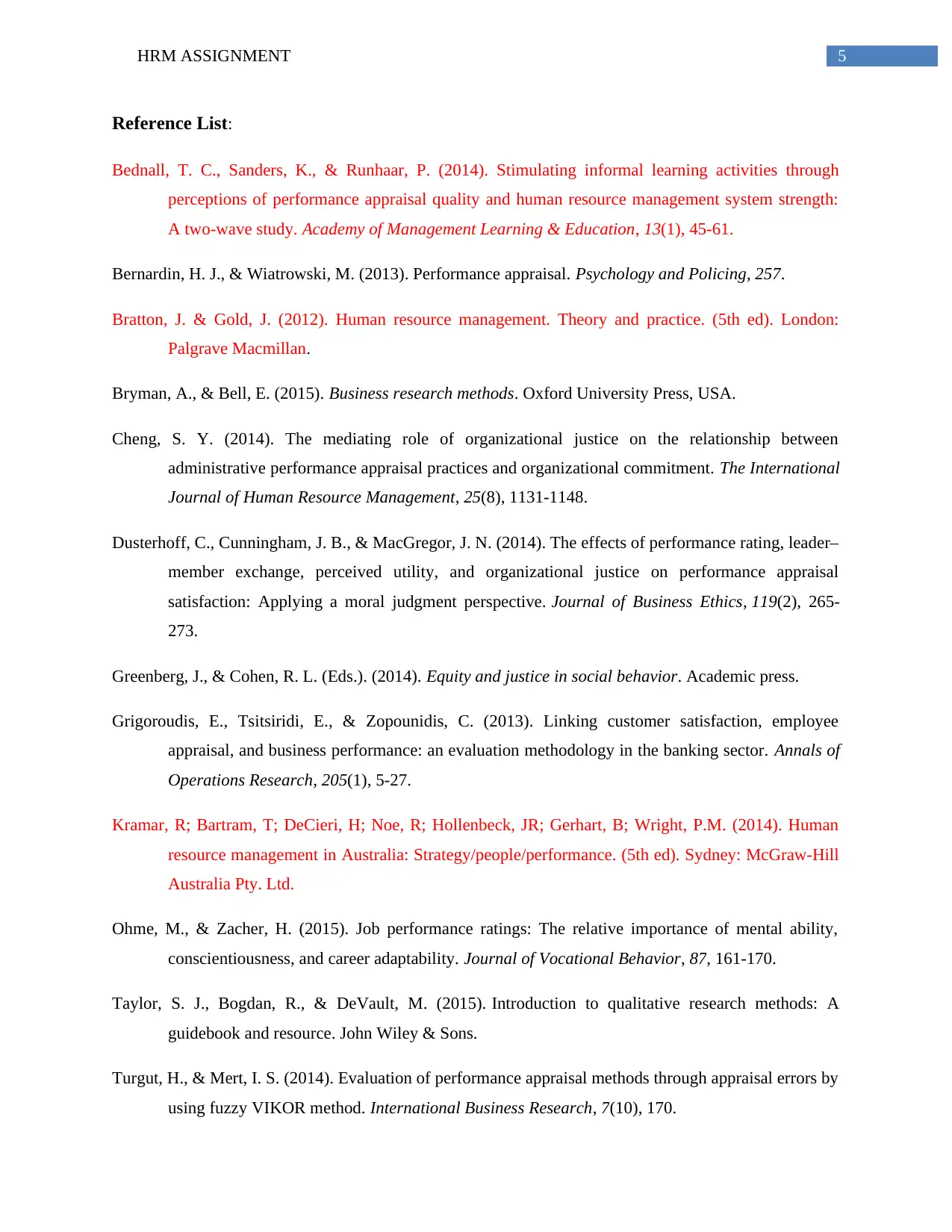
5HRM ASSIGNMENT
Reference List:
Bednall, T. C., Sanders, K., & Runhaar, P. (2014). Stimulating informal learning activities through
perceptions of performance appraisal quality and human resource management system strength:
A two-wave study. Academy of Management Learning & Education, 13(1), 45-61.
Bernardin, H. J., & Wiatrowski, M. (2013). Performance appraisal. Psychology and Policing, 257.
Bratton, J. & Gold, J. (2012). Human resource management. Theory and practice. (5th ed). London:
Palgrave Macmillan.
Bryman, A., & Bell, E. (2015). Business research methods. Oxford University Press, USA.
Cheng, S. Y. (2014). The mediating role of organizational justice on the relationship between
administrative performance appraisal practices and organizational commitment. The International
Journal of Human Resource Management, 25(8), 1131-1148.
Dusterhoff, C., Cunningham, J. B., & MacGregor, J. N. (2014). The effects of performance rating, leader–
member exchange, perceived utility, and organizational justice on performance appraisal
satisfaction: Applying a moral judgment perspective. Journal of Business Ethics, 119(2), 265-
273.
Greenberg, J., & Cohen, R. L. (Eds.). (2014). Equity and justice in social behavior. Academic press.
Grigoroudis, E., Tsitsiridi, E., & Zopounidis, C. (2013). Linking customer satisfaction, employee
appraisal, and business performance: an evaluation methodology in the banking sector. Annals of
Operations Research, 205(1), 5-27.
Kramar, R; Bartram, T; DeCieri, H; Noe, R; Hollenbeck, JR; Gerhart, B; Wright, P.M. (2014). Human
resource management in Australia: Strategy/people/performance. (5th ed). Sydney: McGraw-Hill
Australia Pty. Ltd.
Ohme, M., & Zacher, H. (2015). Job performance ratings: The relative importance of mental ability,
conscientiousness, and career adaptability. Journal of Vocational Behavior, 87, 161-170.
Taylor, S. J., Bogdan, R., & DeVault, M. (2015). Introduction to qualitative research methods: A
guidebook and resource. John Wiley & Sons.
Turgut, H., & Mert, I. S. (2014). Evaluation of performance appraisal methods through appraisal errors by
using fuzzy VIKOR method. International Business Research, 7(10), 170.
Reference List:
Bednall, T. C., Sanders, K., & Runhaar, P. (2014). Stimulating informal learning activities through
perceptions of performance appraisal quality and human resource management system strength:
A two-wave study. Academy of Management Learning & Education, 13(1), 45-61.
Bernardin, H. J., & Wiatrowski, M. (2013). Performance appraisal. Psychology and Policing, 257.
Bratton, J. & Gold, J. (2012). Human resource management. Theory and practice. (5th ed). London:
Palgrave Macmillan.
Bryman, A., & Bell, E. (2015). Business research methods. Oxford University Press, USA.
Cheng, S. Y. (2014). The mediating role of organizational justice on the relationship between
administrative performance appraisal practices and organizational commitment. The International
Journal of Human Resource Management, 25(8), 1131-1148.
Dusterhoff, C., Cunningham, J. B., & MacGregor, J. N. (2014). The effects of performance rating, leader–
member exchange, perceived utility, and organizational justice on performance appraisal
satisfaction: Applying a moral judgment perspective. Journal of Business Ethics, 119(2), 265-
273.
Greenberg, J., & Cohen, R. L. (Eds.). (2014). Equity and justice in social behavior. Academic press.
Grigoroudis, E., Tsitsiridi, E., & Zopounidis, C. (2013). Linking customer satisfaction, employee
appraisal, and business performance: an evaluation methodology in the banking sector. Annals of
Operations Research, 205(1), 5-27.
Kramar, R; Bartram, T; DeCieri, H; Noe, R; Hollenbeck, JR; Gerhart, B; Wright, P.M. (2014). Human
resource management in Australia: Strategy/people/performance. (5th ed). Sydney: McGraw-Hill
Australia Pty. Ltd.
Ohme, M., & Zacher, H. (2015). Job performance ratings: The relative importance of mental ability,
conscientiousness, and career adaptability. Journal of Vocational Behavior, 87, 161-170.
Taylor, S. J., Bogdan, R., & DeVault, M. (2015). Introduction to qualitative research methods: A
guidebook and resource. John Wiley & Sons.
Turgut, H., & Mert, I. S. (2014). Evaluation of performance appraisal methods through appraisal errors by
using fuzzy VIKOR method. International Business Research, 7(10), 170.
⊘ This is a preview!⊘
Do you want full access?
Subscribe today to unlock all pages.

Trusted by 1+ million students worldwide

6HRM ASSIGNMENT
Vamsi Krishna Jasti, N., & Kodali, R. (2014). A literature review of empirical research methodology in
lean manufacturing. International Journal of Operations & Production Management, 34(8),
1080-1122.
Vamsi Krishna Jasti, N., & Kodali, R. (2014). A literature review of empirical research methodology in
lean manufacturing. International Journal of Operations & Production Management, 34(8),
1080-1122.
1 out of 7
Related Documents
Your All-in-One AI-Powered Toolkit for Academic Success.
+13062052269
info@desklib.com
Available 24*7 on WhatsApp / Email
![[object Object]](/_next/static/media/star-bottom.7253800d.svg)
Unlock your academic potential
Copyright © 2020–2025 A2Z Services. All Rights Reserved. Developed and managed by ZUCOL.





